» Currently browsing: Tool-Tips
June 25th, 2016 at 12:45 pm »
Comments (3)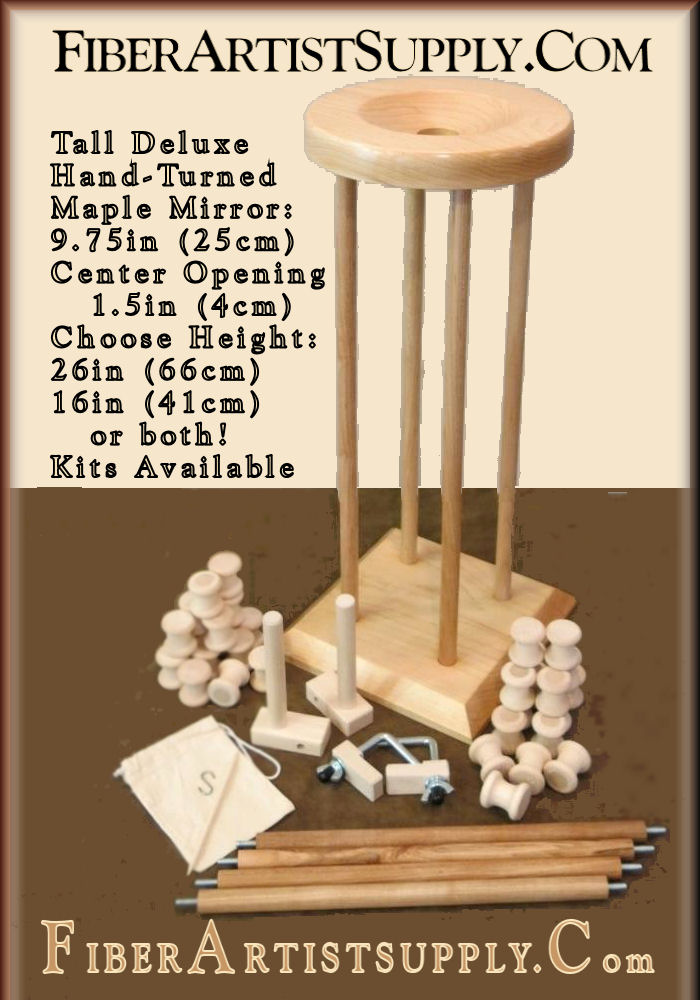 The purpose of this article is to share a starting point of the information necessary to make the best possible investment – time or money – in your choice of braiding equipment.
The purpose of this article is to share a starting point of the information necessary to make the best possible investment – time or money – in your choice of braiding equipment.
Let me make it clear – There is nothing wrong with using a disc or improvised or self made braiding equipment. If that is what is currently in your budget. Many of us have; some including me, still do use both MaruDai and other types braiding stands, just remember flat tops are not Marudai and your results may not be of the quality you hope to achieve. And, I DO recommend you “buy a book” and try with improvised equipment as the first step in your research.
In their beginner books Carey & Owen give ideas for improvised equipment – and see if you enjoy it. the braids will not be perfect or wonderful, that comes with better equipment and practice. Remember: There are many types of braiding equipment not every stand is Japanese in style, or evea a MaruDai and it cannot be said often enough – NOT all braids are Kumihimo.
What makes it a Marudai and not “just” a braiding Stand? Whether you know the Japanese name: Hakomi or the often used “English” words like Scoop or Well or Bowl …
The Hakomi Matters.
Without a Hakomi it is not a Marudai
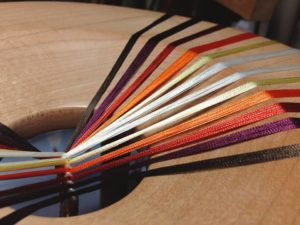 Hekomi Side View
Hekomi Side View
courtesy: Michael Hattori
Why is the Hakomi critical. Perhaps the best answer can be found in two message threads in the FaceBook group: Kumihimo Braiders International in July of 2014 when Michael Hattori was asked, as part of the discussion related to his “announcement:” of his YouTube video and shared with his specific permission:
.. how important is the well in a mirror? I bought one without a well ….
And Michael responded: … we are talking about basics.
The “well” is one of my soapbox topics, and you asked for it! The well is one of THE most important features of a marudai, and in my opinion, any marudai without one should not be used. Its purpose it to provide a “free” space where the threads do not touch the marudai; this allows the threads to fall naturally into place. The depth of the well also causes the threads to angle down toward the point of braiding – another feature which helps the braid to form correctly.
If your mirror is completely flat, the threads move in a straight line to the point of braiding; this means there is friction on the thread almost all the way to the point of braiding, which impedes the formation of the braid. If you are doing just a Yotsu-gumi, you can get away with it, but once you start working with larger numbers of tama, it is absolutely essential.
I’ve said it a million times before, and I’ll say it again: kumihimo has been around for centuries, and the Japanese are known for their ability to refine things to levels unprecedented elsewhere in the world. So, you can bet that every single design aspect of a marudai has been thought out and trialed over hundreds of years and nothing has been left to chance.
It is the folly, unfortunately, of many people who try to make their own kumihimo equipment that this is not taken into consideration, and essential things such as the well are left out.
My advice is to either get a marudai with the well, or find someone who can put one on the marudai you have, paying very close attention to the width, depth and curvature of it.
Sorry for the novel, but you did hit on one of my biggest pet peeves about homemade kumihimo equipment! But I hope I’ve helped you to understand the importance of using a properly made marudai.
2014-07-28 in KBI, Michael shared photos and this additional thoughts.
For … anyone else interested in the “why” of the well on a marudai: a picture is worth a thousand words.
Many homemade marudai are missing this essential feature. These photos show the downward angle and the all-important free space created by the well, both of which allow the braid to “breathe” and form naturally at the point of braiding. The problem with a completely flat mirror is that the threads are then subjected to friction almost all the way to the point of braiding, which can impede the correct formation of the braid; the more tama you are using, the more important this feature becomes.
The marudai has been around for several centuries, and with the Japanese penchant for ultra-refinement, you can bet they haven’t missed anything! So, in my humble opinion, if it ain’t got a well, it ain’t a marudai!
Michael has established the minimum criteria for “what makes it a MaruDai, Well, exactly” – it does not mean other equipment cannot be used, it is just not a MaruDai – Like Michael Hattori I agree if it lacks a Well, then it is not a MaruDai, it is a Braiding Stand – and that tool also has an honorable history, but its roots are not in Japan.
I understand personal budget issues, so like many, it was quite a while before I could afford a Marudai that would “works best for me”. Well worth the wait. That does not mean my braiding stand(s) have not been used, and each as a personal history – only that I always knew my traditional braids would be so much better when I had one.
Meanwhile, for some of the more non-traditional work, beaded braids, wire word and of course – occasional side trips into Victorian Hair work, the flat top continued to be adequate to those tasks.
Thinking about making your own?
Michael Hattori’s measured drawing can be downloaded from my Kumihimo Links Page
added 2015-Jan-09: Not sure if it is mentioned in the Measured Drawing PDF – there are different schools of thought on the height – as was recommended to me (and reinforced by learning the reality the hard way) the top of your mirror should be about the same when you arms are at straight down your side from shoulder to elbow and your forearm is at a 90-95 degree angle to your body. With good back support, this enables me to braid for longer periods
Want to chat about this and related Jewelry & Accessory Making? Join us on FaceBook at: Braids Beaded Kumihimo & More with many thanks to Makiko Tada, Jacquie Carey, Michael Hattori, Carol Miller Franklin, Maryse Levinson, Shirley Berlin, Tim Hale (FiberArtistSupply, Carol Haushalter (Carolyn910), Janis Saunders (BraidersHand). Anita Clark and dozens of others for their permission to include their thoughts and illustrations. Not to mention their decades of patient willingness to answer all my questions about the details and delights of Kumihimo and all braiding techniques.
originally published (and still shared) via ItsAllJustString.COM – Kumihimo and Braiding
Marudai’s I have used and happily recommend: *click for larger image in a new window”
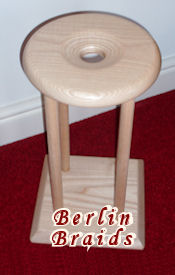
Berlin Braids
|
|
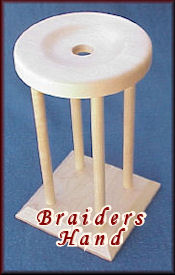
BraidersHand
|
|
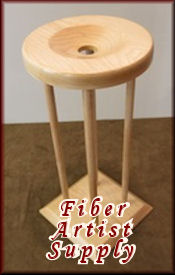
FiberArtistSupply
|
These books will be valuable to you even if you decide to stick with the Disc. There are many “details” of braiding that will better enable you to take the step from Disc to Dai
March 10th, 2016 at 11:30 am »
Comments (0)
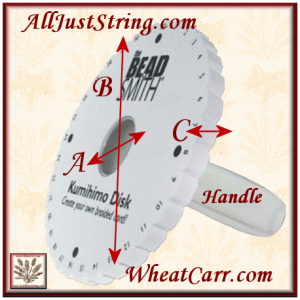
ID=A – Inner Diameter OD=B – Outer Diameter HT=C – Height / Thickness
| Brand Name |
SRP* |
Size |
Handle
Fit |
Center_A
ID_Inches |
Center_A
ID_MM |
Disc
OD_Inches |
Disc
OD_CM |
Disc
HT_Inch |
Disc
HT_MM |
| BeadSmith DD * |
5.00 |
Large |
yes |
1 1/4 in |
35 mm |
5 13/16 in |
15 cm |
0.75in |
20mm |
| BeadSmith DD Mini * |
4.50 |
Small |
yes |
1 1/4 in |
14 mm |
4 3/16 in |
10.6 cm |
0.75in |
20mm |
| BeadSmith SD * |
3.38 |
Large |
yes |
15/16 in |
14mm |
5 13/16 in |
15 cm |
0.375in |
10mm |
| BeadSmith SD Mini: * |
3.18 |
Small |
|
15/16 in |
14 mm |
4 3/16 in |
10.6 cm |
0.375in |
10mm |
| Beadaholique: |
5.49 |
Large |
no |
7/8 in |
12 mm |
5 7/8 in |
15 cm |
0.3125in |
8mm |
| Beadalon |
3.19 |
Small |
no |
15/16 in |
14mm |
4 1/4in |
10.8 cm |
0.375in |
10mm |
| Beadalon |
3.99 |
Large |
no |
15/16 in |
14mm |
6 in |
15 cm |
0.375in |
10mm |
| Dazzle-it: |
3.99 |
Large |
no |
15/16 in |
12 mm |
5 7/8 in |
15 cm |
0.3125in |
8mm |
| Fire Mountain |
3.52 |
Small |
no |
7/8 in |
12 mm |
4 1/4in |
10.8 cm |
.3125in |
8mm |
| Hamanaka: |
10.00 |
Large |
no |
15/16 in |
14mm |
5 7/8 in |
15 cm |
.4375in |
12mm |
| Sally Battis: |
8.00 |
Large |
no*** |
1 1/4 in |
35 mm |
5 1/2in |
14 cm |
0.75in |
20mm |
| Toner 4-pk |
6.99 |
Small |
no |
3/4 in |
20 mm |
4 1/4in |
10.8 cm |
.3125in |
8mm |
| Weir: |
3.95 |
Large |
yes |
1 1/4 in |
35 mm |
5 1/2in |
14 cm |
0.4375in |
12mm |
| |
|
|
|
|
|
|
|
|
|
With thanks to Carolyn910, BeadSmith, and Sally Battis for providing some details. And BeadSmith for written permission to use their images.
|
| * SRP is the advertised Suggested Retail Price – last updated 2016-March-10 – Always check your seller for most recent price. |
| ** Prior to 2015 BeadSmith SD discs has 25mm center – this do not fit the BeadSmith Handle – price used is with instruction for 8 and 16 Round Spiral (Japanese Name: Kongo Gumi ). |
| *** Sally Battis disc has a beveled center opening on the bottom. As a result, although the same Center hole ID on top/numbered side, it likely will not support the BeadSmith handle. |
Comments, additional details, questions, corrections always welcomed
If you would like to see the line of BeadSmith Disc for Braiding
visit our e-store by clicking here to see our products and pricing
February 9th, 2015 at 12:33 pm »
Comments (1)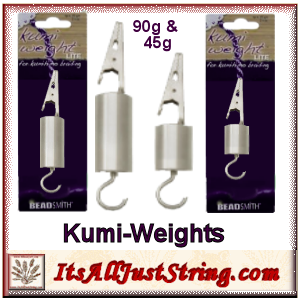
With the recent announcement of the new accessory for Braiding on Disc – the Kumi-Handle – it seemed like a good idea to address another braiding aid, the Counterweight.
Although I have spent many hours working with a counterweight on a disc so I would understand its use; I do not usually use one. Just not how I learned.
Shown above is the recently released (Fall 2015) version offered by The BeadSmith and the one you will most readily find in my e-store. There are many DIY Solutions and eventually I may put together a list but for today…
So for today’s addition to the “department of general information” espoused by Shirley Berlin – some background on the the three currently commercially available versions of counterweight. It is possible I missed some, but here is what I can “Verify”
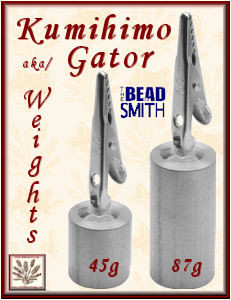
First produced in Canada by Jamie North’s partner – Kevin Swanson were the Gator Weights – but like many basically one man operations, with the explosion in braiding interest they apparently had some difficulty meeting demand. I know I often waited weeks for BeadSmith to get shipments and seem to always have the item in back order. These weigh approximately 45gm and 87gm and are slightly larger in diameter than the current Kumi-Weight.
About a year or so ago, the next addition to the counterweight field was put out by Beadalon. There version shown in the compatibility photo are intended for use with their spool knitter and for kumihimo.
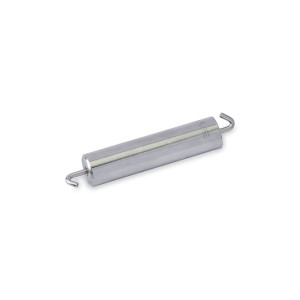
The Beadalon hooks are not unlike some machine knitting weights I have use. I have never seen these in person so cannot speak from experience. Like all tools I am sure they will have fans. Still given how I feel about the Knitting Machine hooks I have like that is the look of their hook – I suspect even at their much lower price point, they might not be my preferred solution when a counterweight is required.
Within the product description on my e-shop is more of my thoughts – but I admit to being amused that the first thing TH said was “you won’t use those, the alligator clip will damage your fine threads” – not an issue for those only doing beaded braids with SLon cord.
This all need more thought, but I guess if I were not up for some DIY solutions, then I like that the most recent entry into the market has both the alligator clip and a hook (although I know the folks at BeadSmith have no clue how I will use it besides holding down the table cover on the picnic table.
What is important – is the consideration for those reliant on the counterweight if they will also be using the new Kumi-Handle. With that in mind, I will continue to work with my Handle, use the weight and share my findings.

Looking forward to your thoughts, comments, correction and divergent opinions on to counterweight or not.
p.s. still fact checking the timeline, I know I have the order correct, just need to check further on the exact dates.
August 2nd, 2014 at 12:00 pm »
Comments (2) In case you missed hearing about my present of the year, well maybe 2 years – this is about the FiberArtistSupply.com Deluxe Marudai kit –
In case you missed hearing about my present of the year, well maybe 2 years – this is about the FiberArtistSupply.com Deluxe Marudai kit –
Apologies in advance for gushing more than a little. Wheat (me) is an especially happy customer of FiberArtistSupply after recently receiving my “dream” Kumihimo equipment.
Tim Hale and his company, FiberArtistSupply have been supplying affordable quality tools to the yarn community since about 2007 – when I saw the photos of Tim and his family on Facebook, I was surprised that he is such a young guy – great news for the yarn users of the universe.
Since 2008 I have acquired more than a few of Tim’s Tools. Now, I am grateful that about the same time I decided it was time to follow the tradition of commissioning a marudai to meet my personal needs, Tim was just about ready to embark on a “redesign” of his Marudai and gave me the the opportunity to be among those providing input into the redesign.
I love traditional fiber as much as the quite recent practice of adding beads and other inclusion into the braid. (and, yes, have always know that what I was doing was braiding, but not exactly Kumhimio) My biggest wish was for a larger than usual center opening for the mirror than is now standard for Tim’s Tall Deluxe Marudai. My “kit” included both weights of tama – a minimum of 16 each and both sets of legs.
The 9.75 inch diameter mirror is excellent for my preferred 8-16 tama projects and adequate for the occasional mad foray into 24 tama braids. My goal is to eventually add another 8 as I use them as both tama and counterweight.
One of the issues with the taller “American” style of Marudai is that the traditional friction fit for the legs to allow easy set up and take down gets a bit wonky and wobbly. Add in the sometimes less than perfectly controlled movements for someone regaining muscle use and memory and Tim’s new screw in legs are a personal Godsend.
A compromise was needed related to the finishing. As a young woodworker Tim has some strong feelings about finishing. After listening – I had to agree that if the result was a more appropriate finish there was no reason not to take advantage of the kinds of finishes available today for the Marudai mirror.
So, after months of “engineer meets artisan” that included lots of me explaining WHY that detail was important in terms that would appeal to his sense of engineering and my desire for a reasonably traditional work and his educating me the nuances of creating a design for hand crafted production it finally arrived (early July) – I have been braiding happily away on samples for a future book “to test” the limits of my new toy and am not the only one amazed and amuzed to find nothing I would change or wish was different.
I am not sure if Tim will consider working on a custom project anytime soon (and I take full responsibility and hold him blameless) but am very pleased with the outcome of this one.
The only thing left on my braiding “I want” list are larger capacity bobbins and rumor has it Tim will be solving that problem for all very soon – well that and more time to braid and bead and weave, and most important of all ….
Enjoy The Making
Wheat
Oh, almost forgot – for ordering, pricing and availablity, visit FiberArtistSupply.com and check out the Kumihimo tools. Web Links Open In New Windows:
Kumihimo Tools at FiberArtistSupply
E Mail FiberArtSupply
Telephone: 847-530-0816
Email FiberArtistSupply
CC: Kumihimo Marudai Resource Links
CC: AllJustString.com Forum
FB: ItsAllJustString.com
August 20th, 2007 at 00:01 am »
Comments (2)Calipers are a measuring tool which I find indispensable for measuring Aluminum and Plastic and Wood Crochet Hooks and Knit Needles. That is why I love these little 4 inch,
Brass Calipers
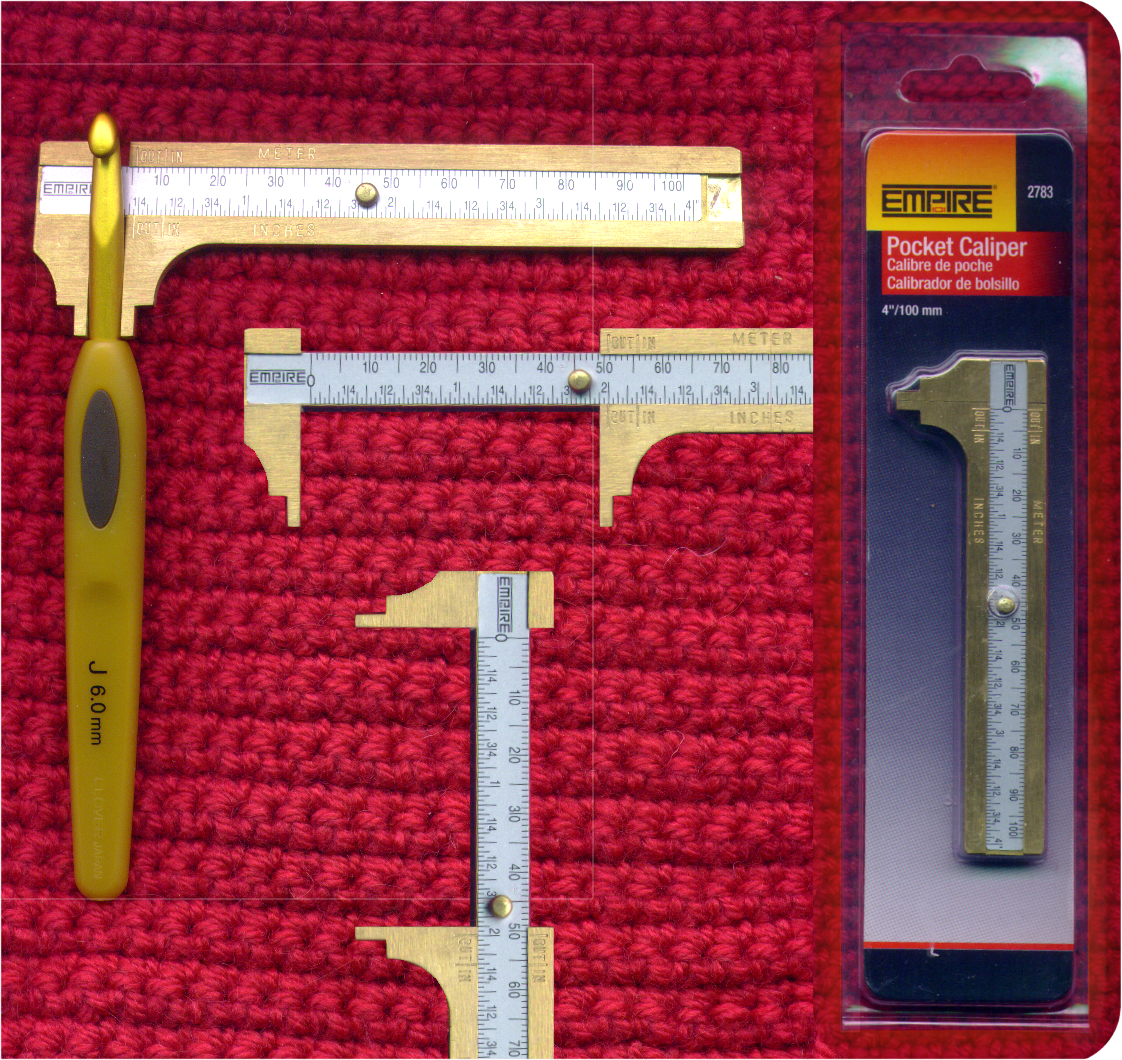
click for larger image
It is my experience that most of the “4 inch” (which have an overall length of about 4.5 inches) will fit into most any “tool kit” even one as compact as Clover Knit YARN Mate has enough room to include this and a few other “Hooking Necessities“.
For many reasons, none of the handy dandy devices measuring Knitting Needles really work well for Crochet hooks and all to often “stop” at the most common sizes at either end of the size range.
This particularly true for those of use who prefer the type of Crochet hook end found on Clover & Pony Hooks (slightly larger diameter than the barrel).
Obviously you cannot get an accurate measurement of the shaft’s diameter, using the little devices sold for knitting, because you have to be able to get the end thru. If the head of your hook is larger than the hole (unlike knitting needles with tapered points) it just does not work.
Nor, can you use the existing knitting measuring devices for our Double Ended tools, never mind needed into know estoreric details like the Diameter of Grant’s One Needle Looper vs, the K-Tel Knitter or the various sizes of Locker Hooks
For a designer, who needs to include accurate “gauge using x size hook and such and so yarn”
Add to that my need to have the enlarged handles such as Clover’s Soft Touch – so you can’t just poke the butt end thru… well you get the idea.
At just over 4.5 inch long, they easily fit into your pocket or hook pouch and at $7.99 (Sears) to $16 (Duluth Trading) or on average in your local Bead Shop – $11 – they are a worthwhile investment.
Okay too much for the occasional need to measure a Crochet Hook or Knit Needle? but what about gauge? As you can see in the picture, it is really easy to lay the caliper open as much as four inches (although I suggest no more than three and usually am happy with 2 inches) to check your gauge stitches or rows per inch and inch or two to quickly determine wraps per inch for weaving.
Just one small caveat – these are accurate to 1mm, and you can, with practice “eyeball” to .5mm, but I do not recommend using this device to accurately measure your steel hooks under 1mm or any hooks over 1mm to less than .5mm (ie, easy to see 3.5, hard to see 3.75 and certainly no way to be sure of 2.25 vs 2.3) When I need to measure those, either I just hand the box over to the inhouse engineer and his fancy dancy electronic caliper or I use a round wire measuring tool.
or, if you require tools that can measure that small for jewelry purposes I would ask at a reputable jeweler’s supply like the folks at Metalliferious in NYC.
I also find these very useful when making changes to a flat pattern – but that may be because they are there
Hope This Helps
Wheat
P.S. Yes there are cheaper plastic Calipers sold in craft and hobby stores. I was so dissatisfied with their quality and accuracy that I trashed them and consider it dollars down the tubes.
Added 8/23: I am told the quality has improved, so will be looking into these less expensive – small plastic versions.
P.S. Jr, I “reduced so it would fit” the picture of the “still in the package” calipers so you would know what to look for in Sears or woodworking stores (or the tool box of someone who might not miss them immediately if you are discreet about their appropriation for better use)
 The purpose of this article is to share a starting point of the information necessary to make the best possible investment – time or money – in your choice of braiding equipment.
The purpose of this article is to share a starting point of the information necessary to make the best possible investment – time or money – in your choice of braiding equipment.




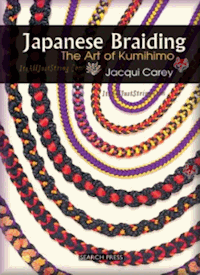
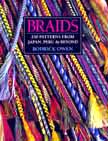





 In case you missed hearing about my present of the year, well maybe 2 years – this is about the FiberArtistSupply.com Deluxe Marudai kit –
In case you missed hearing about my present of the year, well maybe 2 years – this is about the FiberArtistSupply.com Deluxe Marudai kit – 